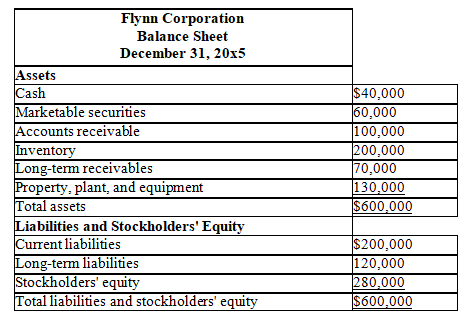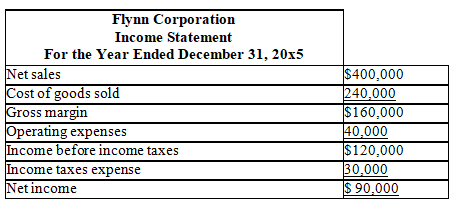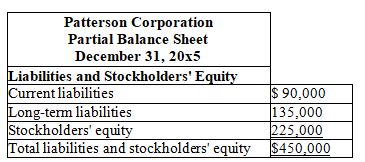Correct Answer

verified
Correct Answer
verified
True/False
The operating cycle is equal to days' sales uncollected plus days' inventory on hand minus days' payable.
Correct Answer

verified
Correct Answer
verified
Multiple Choice
Quality of earnings is affected by all of the following except
A) executive compensation.
B) accounting methods.
C) accounting estimates.
D) one-time items.
Correct Answer

verified
Correct Answer
verified
Multiple Choice
A common measure of long-term solvency is the
A) receivable turnover.
B) asset turnover.
C) debt to equity ratio.
D) current ratio.
Correct Answer

verified
Correct Answer
verified
True/False
In horizontal analysis,the base year is the most current year being examined.
Correct Answer

verified
Correct Answer
verified
True/False
Vertical analysis will reveal the percentage of net sales consumed by salaries expense.
Correct Answer

verified
Correct Answer
verified
Multiple Choice
If sales for 20x4 (the base year) ,20x5,and 20x6 are $40,000,$31,200,and $49,200,respectively,the index numbers assigned to 20x5 and 20x6,respectively,are
A) 62.4 and 128.
B) 156 and 118.
C) 128.2 and 133.
D) 78 and 123.
Correct Answer

verified
Correct Answer
verified
Essay
Prepare a horizontal analysis by computing the amounts and percentage changes for the following balance sheet items;place your answers in the blanks provided.

Correct Answer

verified
Correct Answer
verified
Multiple Choice
Following are the financial statements for Flynn Corporation for the year ended December 31,20x5.Assume that all balance sheet amounts represent both average and ending figures. 
 -What is the return on assets for this corporation? Round your answer to one decimal place.
-What is the return on assets for this corporation? Round your answer to one decimal place.
A) 37.5 percent
B) 26.7 percent
C) 20.0 percent
D) 15.0 percent
Correct Answer

verified
Correct Answer
verified
Multiple Choice
Vertical analysis of comparative financial statements includes the
A) development of common-size statements.
B) calculation of dollar amount changes and percentage changes from the previous to the current year.
C) use of an index number.
D) All of these choices.
Correct Answer

verified
Correct Answer
verified
True/False
The price/earnings (P/E)ratio is an indication of investor confidence in a company.
Correct Answer

verified
Correct Answer
verified
Multiple Choice
Sleepy Monk Coffee Company operates a chain of retail coffee shops and also sells its signature roasted coffee to local resorts.Which of the following accounting estimates would be most important for Sleepy Monk Coffee Company?
A) Uncollectible accounts receivable.
B) Warranty claims.
C) Depreciable lives for its operating assets.
D) Sales returns.
Correct Answer

verified
Correct Answer
verified
True/False
The use of rule-of-thumb measures is superior to comparison of financial measures or ratios of the same company over a period of time.
Correct Answer

verified
Correct Answer
verified
Multiple Choice
Liquidity ratios are an indication of a company's
A) ability to effectively employ its resources.
B) overall debt to equity position.
C) overall debt position.
D) ability to pay bills when they are due and to meet unexpected needs for cash.
Correct Answer

verified
Correct Answer
verified
True/False
Per the Sarbanes-Oxley Act of 2002,public corporations must establish a compensation committee to determine how its top executives will be compensated.
Correct Answer

verified
Correct Answer
verified
True/False
Companies in the same industry are not required to use the same methods to value inventory and to depreciate similar assets.
Correct Answer

verified
Correct Answer
verified
Multiple Choice
The existence of diversified companies makes which of the following very difficult?
A) Comparison with industry norms
B) The preparation of interim financial statements
C) Use of more than one depreciation or inventory method
D) The compilation of segment information
Correct Answer

verified
Correct Answer
verified
True/False
Asset turnover is most closely associated with a company's liquidity position.
Correct Answer

verified
Correct Answer
verified
Multiple Choice
The following information pertains to Patterson Corporation.Assume that all balance sheet amounts represent both average and ending figures. 
 Patterson Corporation had 6,000 shares of common stock issued and outstanding.The market price of Patterson common stock on December 31,20x5,was $20.Patterson paid dividends of $0.90 per share during 20x5.
-What is the return on equity for this corporation? Round your answer to 1 decimal place.
Patterson Corporation had 6,000 shares of common stock issued and outstanding.The market price of Patterson common stock on December 31,20x5,was $20.Patterson paid dividends of $0.90 per share during 20x5.
-What is the return on equity for this corporation? Round your answer to 1 decimal place.
A) 5.0 percent
B) 10.0 percent
C) 23.3 percent
D) 53.3 percent
Correct Answer

verified
Correct Answer
verified
Multiple Choice
Examples of one-time items include
A) nonoperating items.
B) uncollectible accounts receivable.
C) warranty claims.
D) environmental cleanup costs.
Correct Answer

verified
Correct Answer
verified
Showing 121 - 140 of 164
Related Exams